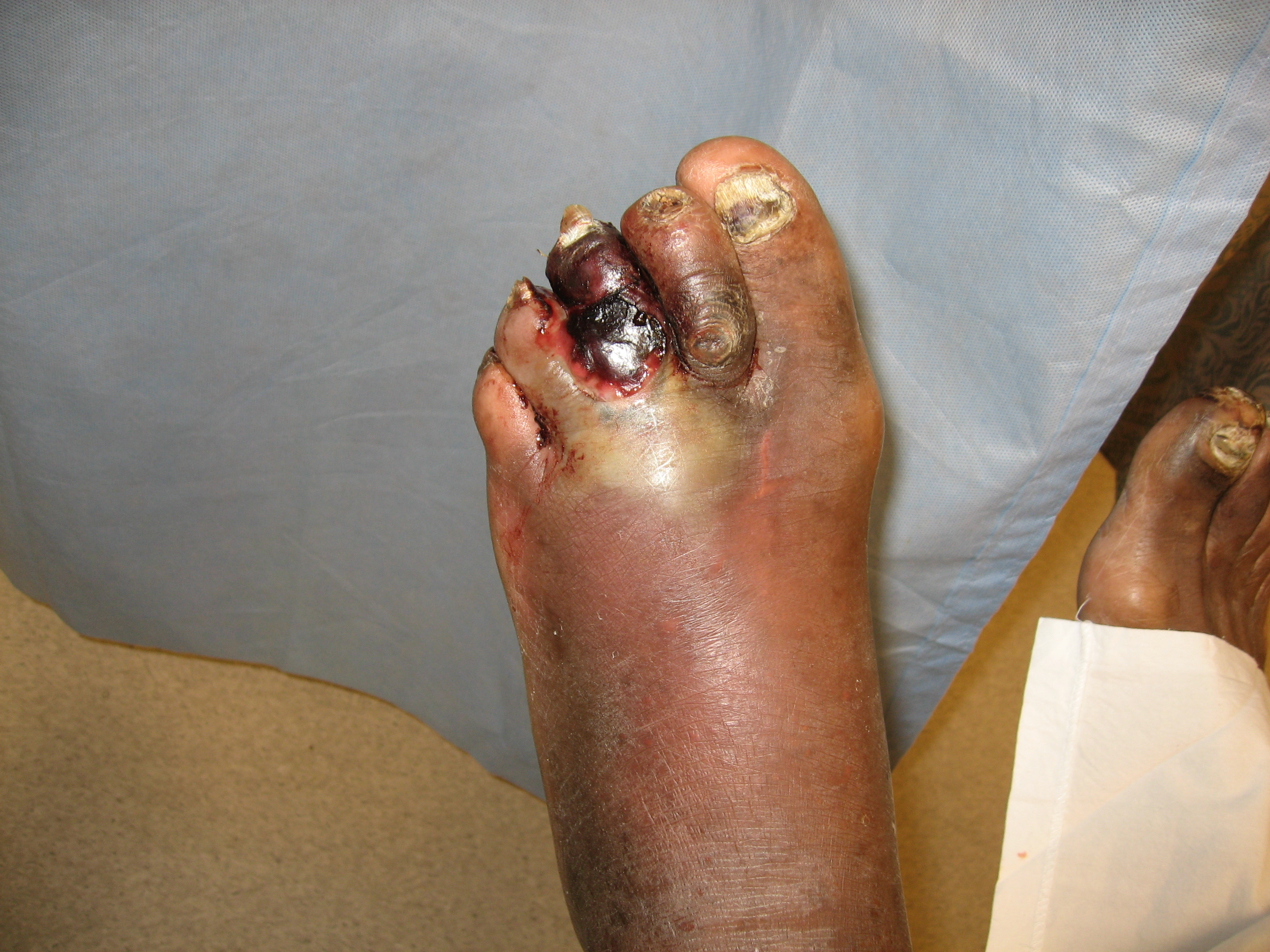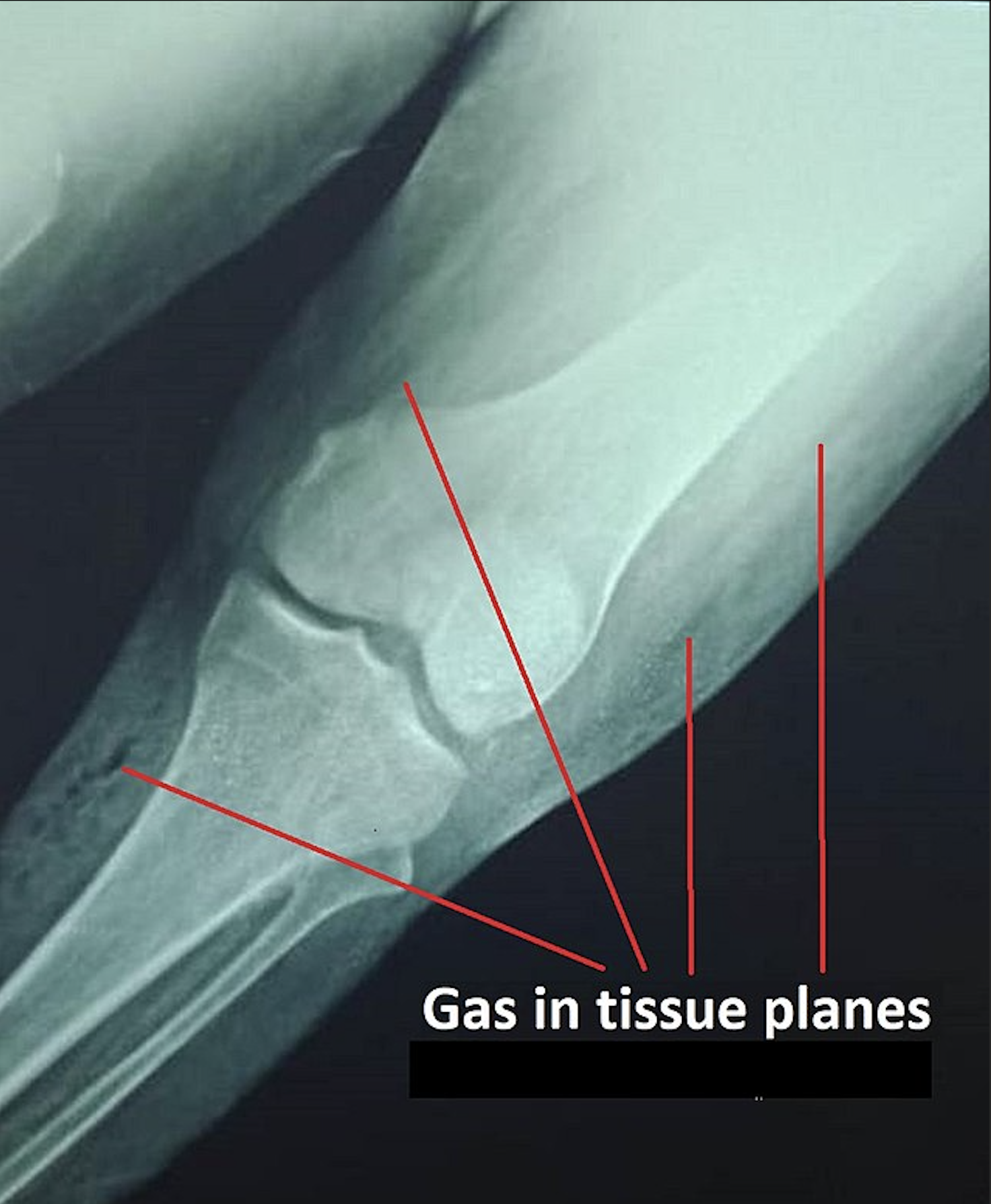[1]
Takehara M, [Host Defense against Bacterial Infection and Bacterial Toxin-induced Impairment of Innate Immunity]. Yakugaku zasshi : Journal of the Pharmaceutical Society of Japan. 2018
[PubMed PMID: 30270267]
[3]
Huang YY,Lin CW,Yang HM,Hung SY,Chen IW, Survival and associated risk factors in patients with diabetes and amputations caused by infectious foot gangrene. Journal of foot and ankle research. 2018
[PubMed PMID: 29312468]
[4]
Perkins TA, Bieniek JM, Sumfest JM. Solitary Candida albicans Infection Causing Fournier Gangrene and Review of Fungal Etiologies. Reviews in urology. 2014:16(2):95-8
[PubMed PMID: 25009452]
[5]
Dempsey A, Serious infection associated with induced abortion in the United States. Clinical obstetrics and gynecology. 2012 Dec
[PubMed PMID: 23090457]
[6]
Stevens DL, Bryant AE. Necrotizing Soft-Tissue Infections. The New England journal of medicine. 2017 Dec 7:377(23):2253-2265. doi: 10.1056/NEJMra1600673. Epub
[PubMed PMID: 29211672]
[7]
Shindo Y,Dobashi Y,Sakai T,Monma C,Miyatani H,Yoshida Y, Epidemiological and pathobiological profiles of Clostridium perfringens infections: review of consecutive series of 33 cases over a 13-year period. International journal of clinical and experimental pathology. 2015
[PubMed PMID: 25755747]
Level 2 (mid-level) evidence
[8]
Lehnhardt M,Homann HH,Daigeler A,Hauser J,Palka P,Steinau HU, Major and lethal complications of liposuction: a review of 72 cases in Germany between 1998 and 2002. Plastic and reconstructive surgery. 2008 Jun
[PubMed PMID: 18520866]
Level 3 (low-level) evidence
[9]
Takazawa K,Otsuka H,Nakagawa Y,Inokuchi S, Clinical Features of Non-clostridial Gas Gangrene and Risk Factors for In-hospital Mortality. The Tokai journal of experimental and clinical medicine. 2015 Sep 20
[PubMed PMID: 26369267]
[10]
Janik E, Ceremuga M, Saluk-Bijak J, Bijak M. Biological Toxins as the Potential Tools for Bioterrorism. International journal of molecular sciences. 2019 Mar 8:20(5):. doi: 10.3390/ijms20051181. Epub 2019 Mar 8
[PubMed PMID: 30857127]
[11]
Srivastava I,Aldape MJ,Bryant AE,Stevens DL, Spontaneous C. septicum gas gangrene: A literature review. Anaerobe. 2017 Dec
[PubMed PMID: 28780428]
[12]
Crum-Cianflone NF, Infection and musculoskeletal conditions: Infectious myositis. Best practice & research. Clinical rheumatology. 2006 Dec
[PubMed PMID: 17127198]
[13]
Carter GP,Cheung JK,Larcombe S,Lyras D, Regulation of toxin production in the pathogenic clostridia. Molecular microbiology. 2014 Jan
[PubMed PMID: 24563915]
[15]
Roberts EJ,Martucci JA,Wu D, The Unusual Presence of Gas From a Puncture Wound: A Case Report. The Journal of foot and ankle surgery : official publication of the American College of Foot and Ankle Surgeons. 2018 Jul - Aug
[PubMed PMID: 29571810]
Level 3 (low-level) evidence
[16]
Cristoferi G,Fabris G,Ronconi AM,Bozza F,Gallassi GC,Bucca D,Caria GM,Duodeci S, [Gas gangrene. Clinical considerations, prognosis and therapeutic prospects in our experience]. Journal de chirurgie. 1991 May
[PubMed PMID: 1880179]
[17]
Sarvari KP,Vasas B,Kiss I,Lazar A,Horvath I,Simon M,Peto Z,Urban E, Fatal Clostridium perfringens sepsis due to emphysematous gastritis and literature review. Anaerobe. 2016 Aug
[PubMed PMID: 27036998]
[18]
Finsterer J,Hess B, Neuromuscular and central nervous system manifestations of Clostridium perfringens infections. Infection. 2007 Dec
[PubMed PMID: 18034207]
[19]
Nichols RL,Smith JW, Anaerobes from a surgical perspective. Clinical infectious diseases : an official publication of the Infectious Diseases Society of America. 1994 May
[PubMed PMID: 8086576]
Level 3 (low-level) evidence
[20]
Shin SH,Park IK,Kang JW,Lee YS,Chung YG, Vacuum-Assisted Closure (VAC) Using Multiple Foam Pieces for Hidden Space Drainage through Less Exposure in Musculoskeletal Infections. The journal of hand surgery Asian-Pacific volume. 2018 Sep
[PubMed PMID: 30282543]
[21]
Yang Z,Hu J,Qu Y,Sun F,Leng X,Li H,Zhan S, Interventions for treating gas gangrene. The Cochrane database of systematic reviews. 2015 Dec 3
[PubMed PMID: 26631369]
Level 1 (high-level) evidence
[22]
Devaney B,Frawley G,Frawley L,Pilcher DV, Necrotising soft tissue infections: the effect of hyperbaric oxygen on mortality. Anaesthesia and intensive care. 2015 Nov
[PubMed PMID: 26603791]
[23]
Bakker DJ, Clostridial myonecrosis (gas gangrene). Undersea & hyperbaric medicine : journal of the Undersea and Hyperbaric Medical Society, Inc. 2012 May-Jun
[PubMed PMID: 22670554]
[24]
Mathieu D, Marroni A, Kot J. Tenth European Consensus Conference on Hyperbaric Medicine: recommendations for accepted and non-accepted clinical indications and practice of hyperbaric oxygen treatment. Diving and hyperbaric medicine. 2017 Mar:47(1):24-32. doi: 10.28920/dhm47.1.24-32. Epub
[PubMed PMID: 28357821]
Level 3 (low-level) evidence
[25]
Gacto-Sanchez P, Surgical treatment and management of the severely burn patient: Review and update. Medicina intensiva. 2017 Aug - Sep
[PubMed PMID: 28456441]
[26]
Pruskowski KA, Pharmacokinetics and Pharmacodynamics of Antimicrobial Agents in Burn Patients. Surgical infections. 2021 Feb;
[PubMed PMID: 33164665]
[27]
Ramos G,Cornistein W,Cerino GT,Nacif G, Systemic antimicrobial prophylaxis in burn patients: systematic review. The Journal of hospital infection. 2017 Oct
[PubMed PMID: 28629932]
Level 1 (high-level) evidence
[28]
Barone M,Grani G,Ramundo V,Garritano T,Durante C,Falcone R, Fournier's gangrene during lenvatinib treatment: A case report. Molecular and clinical oncology. 2020 Jun
[PubMed PMID: 32337042]
Level 3 (low-level) evidence
[29]
Chantre C, Foucher S, Le Hot H, Lefort H, Blatteau JÉ. [Hyperbaric oxygen therapy, a little-known discipline]. Revue de l'infirmiere. 2018 Jun-Jul:67(242):14-15. doi: 10.1016/j.revinf.2018.03.012. Epub
[PubMed PMID: 29907169]
[30]
Burman F, Low-pressure fabric hyperbaric chambers. South African medical journal = Suid-Afrikaanse tydskrif vir geneeskunde. 2019 Mar 29
[PubMed PMID: 31084683]
[31]
Heyboer M 3rd, Hyperbaric Oxygen Therapy Side Effects - Where Do We Stand? The journal of the American College of Clinical Wound Specialists. 2016
[PubMed PMID: 30276115]
[32]
Clark LA,Moon RE, Hyperbaric oxygen in the treatment of life-threatening soft-tissue infections. Respiratory care clinics of North America. 1999 Jun
[PubMed PMID: 10333449]
[33]
Chernyadyev SA, Ufimtseva MA, Vishnevskaya IF, Bochkarev YM, Ushakov AA, Beresneva TA, Galimzyanov FV, Khodakov VV. Fournier's Gangrene: Literature Review and Clinical Cases. Urologia internationalis. 2018:101(1):91-97. doi: 10.1159/000490108. Epub 2018 Jun 27
[PubMed PMID: 29949811]
Level 3 (low-level) evidence
[34]
Chen SY,Fu JP,Wang CH,Lee TP,Chen SG, Fournier gangrene: a review of 41 patients and strategies for reconstruction. Annals of plastic surgery. 2010 Jun
[PubMed PMID: 20407363]
[35]
McGinness K,Kurtz Phelan DH, Use of Viable Cryopreserved Umbilical Tissue for Soft Tissue Defects in Patients With Gas Gangrene: A Case Series. Wounds : a compendium of clinical research and practice. 2018 Apr
[PubMed PMID: 29718818]
Level 2 (mid-level) evidence
[36]
Ingraham AM,Jung HS,Liepert AE,Warner-Hillard C,Greenberg CC,Scarborough JE, Effect of transfer status on outcomes for necrotizing soft tissue infections. The Journal of surgical research. 2017 Dec
[PubMed PMID: 29180205]
[37]
Mills MK,Faraklas I,Davis C,Stoddard GJ,Saffle J, Outcomes from treatment of necrotizing soft-tissue infections: results from the National Surgical Quality Improvement Program database. American journal of surgery. 2010 Dec
[PubMed PMID: 21146022]
Level 2 (mid-level) evidence
[38]
Roloff D, [Prerequisites for the transfer of patients with gas gangrene to a specialized facility]. Anaesthesiologie und Reanimation. 1991
[PubMed PMID: 2043237]
[39]
Sison-Martinez J,Hendriksen S,Cooper JS, Hyperbaric Treatment Of Clostridial Myositis And Myonecrosis . 2020 Jan
[PubMed PMID: 29763178]


